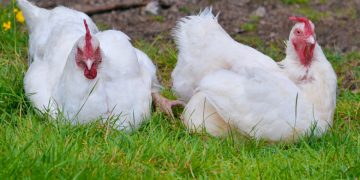The Gâtinaise is a hardy hen from Gâtinais, an ancient region located in the current departments of Loiret, Seine-et-Marne and Yonne. This breed is distinguished by its early laying, its fairly rapid growth, as well as its very assertive brooder instinct. It is a fairly strong and well-balanced bird, appreciated for the quality and rhythm of its laying.
Physical peculiarities
Like the Leghorn, the Gâtinaise has immaculate white plumage, orange eyes, a slightly pink beak and a red crest. The only physical difference with its cousin from Aquitaine being that the Gâtinaise has a denser feathery tail. Its mumps are smooth and red, its tarsi are long, thin and white in color.
Plumage: immaculate white, dense
Eyes: Orange iris
Beak: Orange iris
Crest: red, rather thick and composed of 5 to 7 teeth
Chest: broad and well developed
Mumps: red and smooth, oval in shape
Tarsi: red and smooth, oval in shape
Behavior and character
The Gâtinaise is one of the most affectionate hens. She tends to behave like a pet. This casserole has no apprehension vis-à-vis the man, so that even the smallest will be able to spend wonderful moments in his company without fear. She can also cohabit with other hens of different breeds as well as other barnyard animals.
Gâtinais hens are good laying white eggs weighing 60 g or more. They produce a respectable number (170 eggs per year on average), even during part of the winter. The Gâtinaise is a big incubator, so be sure to collect the eggs regularly, especially if you also have a rooster.
Feed
As a good layer, the Gâtinaise is satisfied with a mixed diet composed of 80% of a specific cereal mixture for layers and 20% of food supplement (crushed nettles, crushed oyster shells, etc.), but you can also leave your hen find other sources of food in the garden. Like most of its gallinaceous congeners, the Gâtinaise appreciates leftovers such as vegetable peelings, but these cannot be its only source of food. In general, count about 120 g of food per day for each hen.
Reproduction
The Gâtinaise is one of the most prolific breeds in terms of egg production. If you have a rooster, there is therefore a good chance that your Gâtinaise will have chicks. If there has been a mating, your hen will then hatch her eggs meticulously without your intervention. A fertilized egg hatches after 21 days of incubation. The Gâtinaise hen is also a caring mother who will take great care over the safety of her chicks.
Health
Like all hens, the Gâtinaise requires a minimum of care. Good food is essential, as well as enough water to quench their thirst (up to half a liter a day in summer).
The Gâtinaise has a well developed chest, a white and tight plumage, it is elegant and agile despite its large size. If your hen no longer fits this description, she probably has a problem. Likewise, if you find that his posture is shaky or his feathers are sparse or unkempt, it may be time to see a veterinarian. Also remember to deworm your chickens to avoid most common parasites.
Gâtinaise hens are not among the breeds with record longevity and rarely reach 15 years old, but in good health and protected from predators, your pullets will easily reach 10 years old.
Place of life
The Gâtinaise is a rustic hen and therefore adapts to any type of habitat, whether it is a chicken coop, a meadow or a garden. It is therefore one of the most popular chicken breeds for individuals.
As its name suggests, this hen comes from Gâtinais, in the north of France, so it is perfectly adapted to our climate and has all the advantages of French hen breeds. Very easy to live with, they adapt easily and are ideal hens to build up a floor.
But the hardiness of such a breed also implies a love of wide open spaces. Moreover, a commercial breeding of Gâtinaises must respect a certain number of rules. Hens should be raised outdoors, fed grain and fresh water, and able to enjoy shade and grassy areas.
During the winter or when your hens spend most of their time in the henhouse, do not forget to renew their litter once a week (at least the soiled parts) and scrape the excrement on the nesting boxes. Outside, simple daily monitoring may be enough, but remain vigilant all the same: lack of hygiene is the first vector of disease in hens. Especially since their droppings are useful, although loaded with azo












